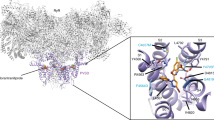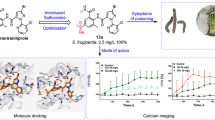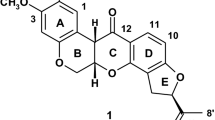Abstract
Ryanodine receptors (RyRs) are a distinct class of ligand-gated calcium channels controlling the release of calcium from intracellular stores. They are located on the sarcoplasmic reticulum of muscle and the endoplasmic reticulum of neurons and many other cell types. Ryanodine, a plant alkaloid and an important ligand used to characterize and purify the receptor, has served as a natural botanical insecticide, but attempts to generate synthetic commercial analogues of ryanodine have proved unsuccessful. Recently two classes of synthetic chemicals have emerged resulting in commercial insecticides that target insect RyRs. The phthalic acid diamide class has yielded flubendiamide, the first synthetic ryanodine receptor insecticide to be commercialized. Shortly after the discovery of the phthalic diamides, the anthranilic diamides were discovered. This class has produced the insecticides Rynaxypyr® and Cyazypyr™. Here we review the structure and functions of insect RyRs and address the modes of action of phthalic acid diamides and anthranilic diamides on insect ryanodine receptors. Particularly intersting is the inherent selectivity both chemical classes exhibit for insect RyRs over their mammalian counterparts. The future prospects for RyRs as a commercially-validated target site for insect control chemicals are also considered.





Similar content being viewed by others
References
Allen PB, Ouimet CC, Greengard P (1997) Spinophilin, a novel protein phosphatase 1 binding protein localized to dendritic spines. Proc Natl Acad Sci USA 94:9956–9961. doi:10.1073/pnas.94.18.9956
Bai N, Lee HC, Laher I (2005) Emerging role of cyclic ADP-ribose (cADPR) in smooth muscle. Pharmacol Ther 105:189–207. doi:10.1016/j.pharmthera.2004.10.005
Balshaw DM, Xu L, Yamaguchi N, Pasek DA, Meissner G (2001) Calmodulin binding and inhibition of cardiac muscle calcium release channel (ryanodine receptor). J Biol Chem 276:20144–20153. doi:10.1074/jbc.M010771200
Bennett DL, Cheek TR, Berridge MJ, De Smedt H, Parys JB, Missiaen L et al (1996) Expression and function of ryanodine receptors in nonexcitable cells. J Biol Chem 271:6356–6362. doi:10.1074/jbc.271.11.6356
Berridge MJ (1993) Inositol trisphosphate and calcium signalling. Nature 361:315–325. doi:10.1038/361315a0
Berridge MJ (1998) Neuronal calcium signaling. Neuron 21:13–26. doi:10.1016/S0896-6273(00)80510-3
Berridge MJ, Cheek TR, Bennett DL, Bootman MD (1996) Ryanodine receptors and intracellular calcium signalling. In: Sorrentino V (ed) Ryanodine receptors: A CRC Pharmacology & Toxicology Series, Basic and Clinical Aspects. CRC Press, New York, pp 119-153
Bers DM (2002) Cardiac excitation-contraction coupling. Nature 415:198–205. doi:10.1038/415198a
Clapper DL, Walseth TF, Dargie PJ, Lee HC (1987) Pyridine nucleotide metabolites stimulate calcium release from sea urchin egg microsomes desensitized to inositol trisphosphate. J Biol Chem 262:9561–9568
Copello JA, Barg S, Sonnleitner A, Porta M, Diaz-Sylvester P, Fill M et al (2002) Differential activation by Ca2+, ATP and caffeine of cardiac and skeletal muscle ryanodine receptors after block by Mg2+. J Membr Biol 187:51–64. doi:10.1007/s00232-001-0150-x
Copello JA, Qi Y, Jeyakumar LH, Ogunbunmi E, Fleischer S (2001) Lack of effect of cADP-ribose and NAADP on the activity of skeletal muscle and heart ryanodine receptors. Cell Calcium 30:269–284. doi:10.1054/ceca.2001.0235
Cordova D, Benner EA, Sacher MD, Rauh JJ, Sopa JS, Lahm GP et al (2006) Anthranilic diamides: A new class of insecticides with a novel mode of action, ryanodine receptor activation. Pestic Biochem Physiol 84:196–214. doi:10.1016/j.pestbp. 2005.07.005
Cordova D, Benner EA, Sacher MD, Rauh JJ, Sopa JS, Lahm GP, et al (2007a) The novel mode of action of anthranilic diamide insecticides – ryanodine receptor activation; Lyga J and Theodoritis G; Synthesis and Chemistry of Agrochemicals Series VII; American Chemical Society; Washington DC, pp 223–234
Cordova D, Benner EA, Sacher MD, Rauh JJ, Sopa JS, Lahm GP, et al (2007b) Elucidation of the mode of action of Rynaxypyr™, a selective ryanodine receptor activator; Ohkawa H, Miyagawa H, Lee PW;Pesticide Chemistry: Crop Protection, Public Health, Environmental Safety; Wiley-VCH; Weinheim, pp 121–125
Coronado R, Morrissette J, Sukhareva M, Vaughan DM (1994) Structure and function of ryanodine receptors. Am J Physiol Cell Physiol 266:C1485–C1504
Currie S, Loughrey CM, Craig MA, Smith GL (2004) Calcium/calmodulin-dependent protein kinase IIdelta associates with the ryanodine receptor complex and regulates channel function in rabbit heart. Biochem J 377:357–366. doi:10.1042/BJ20031043
Du GG, Khanna VK, MacLennan DH (2000) Mutation of divergent region 1 alters caffeine and Ca2+ sensitivity of the skeletal muscle Ca2+ release channel (ryanodine receptor). J Biol Chem 275:11778–11783. doi:10.1074/jbc.275.16.11778
Ebbinghaus-Kintscher U, Luemmen P, Lobitz N, Schulte T, Funke C, Fischer R et al (2006) Phthalic acid diamides activate ryanodine-sensitive Ca2+ release channels in insects. Cell Calcium 39:21–33
Ebbinghaus-Kintscher U, Luemmen P, Raming K, Masaki T, Yasokawa N (2007) Flubendiamide, the first insecticide with a novel mode of action on insect ryanodine receptors. Planzenschutz-Nachrichten Bayer 60:117–140
Fill M, Copello JA (2002) Ryanodine receptor calcium release channels. Physiol Rev 82:893–922
Fusi F, Iozzi D, Sgaragli G, Frosini M (2005) 3,5-Di-t-butylcatechol (DTCAT) as an activator of rat skeletal muscle ryanodine receptor Ca2+ channel (RyRC). Biochem Pharmacol 69:485–491
George CH, Thomas NL, Lai FA (2005) Ryanodine receptor dysfunction in arrhythmia and sudden cardiac death. Future Cardiol 1:531–541. doi:10.2217/14796678.1.4.531
Giannini G, Conti A, Mammarella S, Scrobogna M, Sorrentino V (1995) The ryanodine receptor/calcium channel genes are widely and differentially expressed in murine brain and peripheral tissues. J Cell Biol 128:893–904. doi:10.1083/jcb.128.5.893
Gonzalez-Coloma A, Gutierrez C, Hubner H, Achenbach H, Terrero D, Fraga BM (1999) Selective insect antifeedant and toxic action of ryanoid diterpenes. J Agric Food Chem 47:4419–4424. doi:10.1021/jf990359a
Gutteridge S, Caspar T, Cordova D, Tao Y, Wu L, Smith RM (2003) Nucleic acids encoding ryanodine receptors. US Patent 7,205,147
Hadad N, Martin C, Ashley RH, Shoshan-Barmatz S (1999) Characterization of shepp brain ryanodine receptor ATP binding site by photoaffinity labeling. FEBS 455:251–256
Hall T (2007) Ecological effects assessment of flubendiamide. Pflanzenschutz-Nachrichtern Bayer 60:167–182
Hamilton S (2005) Ryanodine receptors. Cell Calcium 38:253–260. doi:10.1016/j.ceca.2005.06.037
Heal RE (1949) Ryania insecticides. Agric Chem 4:37–91
Herrmann-Frank A, Richter M, Sarkozi S, Mohr U, Lehmann-Horn F (1996) 4-chloro-m-cresol, a potent and specific activator of the skeletal muscle ryanodine receptor. Biochem Biophys Acta 1289:31–40
Hohenegger M, Matyash M, Poussu K, Herrmann-Frank A, Sarkozi S, Lehmann-Horn F, Freissmuth M (1996) Activation of the skeletal muscle ryanodine receptor by suramin and suramin analogs. Mol Pharmacol 50:1443–1453
Jeffries PR, Yu P, Casida JE (1997) Structural modifications increase the insecticidal activity of ryanodine. Pestic Sci 51:33–38. doi:10.1002/(SICI)1096-9063(199709)51:1 ≤ 33::AID-PS605 ≥ 3.0.CO;2-Z
Jenden DJ, Fairhurst AS (1969) The pharmacology of ryanodine. Pharmacol Rev 21:1–25
Kuwajima G, Futatsugi A, Niinobe M, Nakanishi S, Mikoshiba K (1992) Two types of ryanodine receptors in mouse brain: skeletal muscle type exclusively in Purkinje cells and cardiac muscle type in various neurons. Neuron 9:1133–1142. doi:10.1016/0896-6273(92)90071-K
Lahm GP, Selby TP, Freudenberger JH, Stevenson TM, Myers BJ, Seburyamo G et al (2005) Insecticidal anthranilic diamides: a new class of potent ryanodine receptor activators. Bioorg Med Chem Lett 15:4898–4906. doi:10.1016/j.bmcl.2005.08.034
Lahm GP, Stevenson TM, Selby TP, Freudenberger JH, Dubas CM, Smith BK, et al (2007) Rynaxypyr™: A new anthranilic diamide insecticide acting at the ryanodine receptor. In: Ohkawa H, Miyagawa H, Lee PW (eds), Pesticide Chemistry: Crop Protection, Public Health, Environmental Safety;Wiley-VCH; Weinheim, pp 111–120
Ledbetter MW, Preiner JK, Louis CF, Mickelson JR (1994) Tissue distribution of ryanodine receptor isoforms and alleles determined by reverse transcription polymerase chain reaction. J Biol Chem 269:31544–31551
Lehmberg E, Casida JE (1994) Similarity of insect and mammalian ryanodine binding sites. Pestic Biochem Physiol 48:152–154. doi:10.1006/pest.1994.1015
Lehnart SE, Wehrens XH, Laitinen PJ, Reiken SR, Deng SX, Cheng Z et al (2004) Sudden death in familial polymorphic ventricular tachycardia associated with calcium release channel (ryanodine receptor) leak. Circulation 109:3208–3214. doi:10.1161/01.CIR.0000132472.98675.EC
Luemmen P, Ebbinghaus-Kintscher U, Funke C, Fischer R, Masaki T, Yasokowa N, et al (2007) Phthalic acid diamides activate insect ryanodine receptors. In: Lyga J, Theodoritis G (eds) Synthesis and Chemistry of Agrochemicals Series VII; American Chemical Society; Washington DC, pp 235–248
MacKenzie AE, Korneluk RG, Zorzato F, Fujii J, Phillips M, Iles D et al (1990) The human ryanodine receptor gene: its mapping to 19q13.1, placement in a chromosome 19 linkage group, and exclusion as the gene causing myotonic dystrophy. Am J Hum Genet 46:1082–1089
MacKrill JJ (1999) Protein-protein interactions in intracellular Ca2+ -release channel function. Biochem J 337(Pt 3):345–361. doi:10.1042/0264-6021:3370345
Marks AR, Tempst P, Hwang KS, Taubman MB, Inui M, Chadwick C et al (1989) Molecular cloning and characterization of the ryanodine receptor/junctional channel complex cDNA from skeletal muscle sarcoplasmic reticulum. Proc Natl Acad Sci USA 86:8683–8687. doi:10.1073/pnas.86.22.8683
Marx SO, Reiken S, Hisamatsu Y, Gaburjakova M, Gaburjakova J, Yang YM et al (2001) Phosphorylation-dependent regulation of ryanodine receptors: a novel role for leucine/isoleucine zippers. J Cell Biol 153:699–708. doi:10.1083/jcb.153.4.699
Marx SO, Reiken S, Hisamatsu Y, Jayaraman T, Burkhoff D, Rosemblit N et al (2000) PKA phosphorylation dissociates FKBP12.6 from the calcium release channel (ryanodine receptor): defective regulation in failing hearts. Cell 101:365–376. doi:10.1016/S0092-8674(00)80847-8
Masaki T, Yasokawa N, Tohnishi M, Nishimatsu T, Tsubata K, Inoue K et al (2006) Flubendiamide, a novel Ca2+ channel modulator, reveals evidence for functional cooperation between Ca2+ pumps and Ca2+ release. Mol Pharmacol 69:1733–1739. doi:10.1124/mol.105.020339
Masaki T, Yasokawa N, Ebbinghaus-Kintscher U, Luemmen P (2007) Flubendiamide stimulates Ca2+ pump activity coupled to RyR-mediated calcium release in lepidopterous insects. Ohkawa H, Miyagawa H, Lee PW (eds) Pesticide chemistry: crop protection, public health, environmental safety. Wiley-VCH, Weinheim, pp 137–140
Matsuda H, Noma A, Kurachi Y, Irisawa H (1982) Transient Depolarization and Spontaneous Voltage Fluctuations in Isolated Single Cells from Guinea-Pig Ventricles—Calcium-Mediated Membrane-Potential Fluctuations. Circ Res 51:142–151
Meissner G (1986) Ryanodine activation and inhibition of the Ca2+ release channel of sarcoplasmic reticulum. J Biol Chem 261:6300–6306
Meissner G (1994) Ryanodine receptor/Ca2+ release channels and their regulation by endogenous effectors. Annu Rev Physiol 56:485–508. doi:10.1146/annurev.ph.56.030194.002413
Murayama T, Ogawa Y (1997) Characterization of Type 3 ryanodine receptor of sarcoplasmic reticulum from rabbit skeletal muscles. J Biol Chem 272:24030–24037. doi:10.1074/jbc.272.38.24030
Nakai J, Imagawa T, Hakamata Y, Shigekawa M, Takeshima H, Numa S (1990) Primary structure and functional expression from cDNA of the cardiac ryanodine receptor/calcium release channel. FEBS 271:169–177
Nauen R (2006) Insecticide mode of action: return of the ryanodine receptor. Pest Manag Sci 62:690–692. doi:10.1002/ps.1254
Ogawa Y, Murayama T, Kurebayashi N (1999) Comparison of properties of Ca2+ release channels between rabbit and frog skeletal muscles. Mol Cell Biochem 190:191–201. doi:10.1023/A:1006903401123
Otsu K, Willard HF, Khanna VK, Zorzato F, Green NM, MacLennan DH (1990) Molecular cloning of cDNA encoding the Ca2+ release channel (ryanodine receptor) of rabbit cardiac muscle sarcoplasmic reticulum. J Biol Chem 265:13472–13483
Ottini L, Marziali G, Conti A, Charlesworth A, Sorrentino V (1996) Alpha and beta isoforms of ryanodine receptor from chicken skeletal muscle are the homologues of mammalian RyR1 and RyR3. Biochem J 315(Pt 1):207–216
Oyamada H, Murayama T, Takagi T, Iino M, Iwabe N, Miyata T et al (1994) Primary structure and distribution of ryanodine-binding protein isoforms of the bullfrog skeletal muscle. J Biol Chem 269:17206–17214
Paul-Pletzer K, Yamamoto T, Kemoto N, Jimenez LS, Morimoto H, Williams PG, Ma J, Parness J (2005) Probing a putative dantrolene-binding site on the cardiac ryanodine receptor. Biochem J 387:905–909
Pepper BP, Carruth LA (1945) A new plant insecticide for control of the European corn borer. J Econ Entomol 38:59–66
Perez CF, Mukherjee S, Allen PD (2003) Amino acids 1–1, 680 of ryanodine receptor type 1 hold critical determinants of skeletal type for excitation-contraction coupling. Role of divergence domain D2. J Biol Chem 278:39644–39652. doi:10.1074/jbc.M305160200
Pessah IN, Waterhouse AL, Casida JE (1985) The calcium-ryanodine receptor complex of skeletal and cardiac muscle. Biochem Biophys Res Commun 128:449–456. doi:10.1016/0006-291X(85)91699-7
Pessah IN, Stambuk RA, Casida JE (1987) Ca2+-activated ryanodine binding: mechanism of sensitivity and intensity modulation by Mg2+, caffeine and adenine nucleotides. Mol Pharmacol 31:232–238
Puente E, Suner M, Evans AD, McCaffery AR, Windass JD (2000) Identification of a polymorphic ryanodine receptor gene from Heliothis virescens (Lepidoptera: noctuidae). Insect Biochem Mol Biol 30:335–347. doi:10.1016/S0965-1748(00)00009-6
Quane KA, Healy JM, Keating KE, Manning BM, Couch FJ, Palmucci LM et al (1993) Mutations in the ryanodine receptor gene in central core disease and malignant hyperthermia. Nat Genet 5:51–55. doi:10.1038/ng0993-51
Radermacher M, Rao V, Grassucci R, Frank J, Timerman AP, Fleischer S et al (1994) Cryo-electron microscopy and three-dimensional reconstruction of the calcium release channel/ryanodine receptor from skeletal muscle. J Cell Biol 127:411–423. doi:10.1083/jcb.127.2.411
Riddoch FC, Rowbotham SE, Brown AM, Redfern CP, Cheek TR (2005) Release and sequestration of Ca2+ by a caffeine- and ryanodine-sensitive store in a sub-population of human SH-SY5Y neuroblastoma cells. Cell Calcium 38:111–120. doi:10.1016/j.ceca.2005.06.001
Riddoch FC, Brown AM, Rowbotham SE, Redfern CP, Cheek TR (2007) Changes in functional properties of the caffeine-sensitive Ca2+ store during differentiation of human SH-SY5Y neuroblastoma cells. Cell Calcium 41:195–206. doi:10.1016/j.ceca.2006.06.007
Rogers EF, Konivzy FR, Shavel FR, Folkers K (1948) Ryanodine, a new alkaloid from the Ryania speciosa. J Am Chem Soc 70:3086–3088. doi:10.1021/ja01189a074
Schmitt M, Turberg A, Londershausen M, Dorn A (1996) Binding sites for Ca2+-channel effectors and ryanodine in Periplaneta americana-possible targets for new insecticides. Pestic Sci 48:375–385
Scott-Ward TS, Dunbar SJ, Windass JD, Williams AJ (2001) Characterization of the ryanodine receptor-Ca2+ release channel from the thoracic tissues of the lepidopteran insect Heliothis virescens. J Membr Biol 179:127–141. doi:10.1007/s002320010043
Seo A, Tohnishi M, Nakao H, Furuya T, Kodama H, Tsubata K, Fujioka S, Kodama H, Nishimatsu T, Hirooka T (2007) Flubendiamide, a new insecticide characterized by its novel chemistry and biology. In: Ohkawa H, Miyagawa H, Lee PW (eds) Pesticide chemistry: crop protection, public health, environmental safety. Wiley-VCH, Weinheim, pp 127–135
Seok J, Xu L, Kramarcy NR, Sealock R, Meissner G (1992) The 30 S lobster skeletal muscle Ca2+ release channel (ryanodine receptor) has functional properties distinct from the mammalian channel proteins. J Biol Chem 267:15893–15901
Serysheva II, Orlova EV, Chiu W, Sherman MB, Hamilton SL, van Heel M (1995) Electron cryomicroscopy and angular reconstitution used to visualize the skeletal muscle calcium release channel. Nat Struct Biol 2:18–24. doi:10.1038/nsb0195-18
Sitsapesan R, Williams AJ (1996) Modification of the conductance and gating properties of ryanodine receptors by suramin. J Membr Biol 153:93–103
Sonnleitner A, Conti A, Bertocchini F, Schindler H, Sorrentino V (1998) Functional properties of the ryanodine receptor type 3 (RyR3) Ca2+ release channel. EMBO J 17:2790–2798. doi:10.1093/emboj/17.10.2790
Sorrentino V, Giannini G, Malzac P, Mattei MG (1993) Localization of a novel ryanodine receptor gene (RYR3) to human chromosome 15q14–q15 by in situ hybridization. Genomics 18:163–165. doi:10.1006/geno.1993.1446
Suko J, Hellmann G, Drobny H (2001) Short- and long- term functional alterations of the skeletal muscle calcium release channel (ryanodine receptor) by suramin: apparent dissociation of single channel current recording and [3H]ryanodine binding. Mol Pharmacol 59:543–556
Takeshima H (1989) Primary structure and expression from complementary DNA of skeletal muscle ryanodine receptor. Nature 339:439–445
Takeshima H, Nishi M, Iwabe N, Miyata T, Hosoya T, Masai I et al (1994) Isolation and characterization of a gene for a ryanodine receptor/calcium release channel in Drosophila melanogaster. FEBS Lett 337:81–87. doi:10.1016/0014-5793(94)80634-9
Thiene G, Basso C, Danieli GA, Rampazzo A, Corrado D, Nava A (1997) Arrhythmogenic right ventricular cardiomyopathy—a still underrecognized clinical entity. Trends Cardiovasc Med 7:84–90. doi:10.1016/S1050-1738(97)00011-X
Timerman AP, Onoue H, Xin HB, Barg S, Copello J, Wiederrecht G et al (1996) Selective binding of FKBP12.6 by the cardiac ryanodine receptor. J Biol Chem 271:20385–20391. doi:10.1074/jbc.271.34.20385
Tiso N, Stephan DA, Nava A, Bagattin A, Devaney JM, Stanchi F et al (2001) Identification of mutations in the cardiac ryanodine receptor gene in families affected with arrhythmogenic right ventricular cardiomyopathy type 2 (ARVD2). Hum Mol Genet 10:189–194. doi:10.1093/hmg/10.3.189
Tohnishi M, Nakao H, Furuya T, Seo A, Kodama H, Tsubata K et al (2005) Flubendiamide, a novel insecticide highly active against Lepidopterous insect pests. J Pestic Sci 30:354–360. doi:10.1584/jpestics.30.354
Tsubata K, Tohnishi M, Kodama H, Seo A (2007) Chemistry of flubendiamide—discovery, snthesis, and X-ray structure. Pflanzenschutz-Nachrichten Bayer 60:105–116
Vazquez-Martinez O, Canedo-Merino R, Diaz-Munoz M, Riesgo-Escovar JR (2003) Biochemical characterization, distribution and phylogenetic analysis of Drosophila melanogaster ryanodine and IP3 receptors, and thapsigargin-sensitive Ca2+ ATPase. J Cell Sci 116:2483–2494
Verkhratsky A (2005) Physiology and pathophysiology of the calcium store in the endoplasmic reticulum of neurons. Physiol Rev 85:201–279. doi:10.1152/physrev.00004.2004
Waterhouse AL, Pessah IN, Francini AO, Casida JE (1987) Structural aspects of ryanodine action and selectivity. J Med Chem 30:710–716. doi:10.1021/jm00387a022
Wehrens XH, Marks AR (2004) Sudden unexplained death caused by cardiac ryanodine receptor (RyR2) mutations. Mayo Clin Proc 79:1367–1371
Xu L, Jones RV, Meissner G (1993) Effects of local anesthetics on single channel behavior of skeletal muscle calcium release channel. J Gen Physiol 101:207–233. doi:10.1085/jgp. 101.2.207
Xu L, Tripathy A, Pasek D, Meissner G (1999) Ruthenium red modifies the cardiac and skeltal muscle Ca2+ release channels (ryanodine receptors) by multiple mechanisms. J Biol Chem 274:32680–32691
Xu X, Bhat MB, Nishi M, Takeshima H, Ma J (2000) Molecular cloning of cDNA encoding a Drosophila ryanodine receptor and functional studies of the carboxyl-terminal calcium release channel. Biophys J 78:1270–1281
Yano M, Yamamoto T, Ikemoto N, Matsuzaki M (2005) Abnormal ryanodine receptor function in heart failure. Pharmacol Ther 107:377–391. doi:10.1016/j.pharmthera.2005.04.003
Zhang JJ, Williams AJ, Sitsapesan R (1999) Evidence for novel caffeine and Ca2+ binding sites on the lobster skeletal ryanodine receptor. Br J Pharm 126:1066–1074
Zhao F, Li P, Chen SRW, Louis CF, Fruen BR (2001) Dantrolene inhibition of ryanodine receptor Ca2+ release channels. J Biol Chem 276:13810–13816
Zimanyi I, Pessah IN (1991) Pharmacological characterization of the specific binding of [3H]ryanodine to rat brain microsomal membranes. Brain Res 561:181–191
Acknowledgments
The authors are indebted to their colleagues, Dr. S.D. Buckingham and Dr. A.K. Jones (Oxford), Prof. K. Matsuda (Kinki University, Nara), Dr. Y. Tao, Dr. J.J. Rauh, Dr. G.P. Lahm and E.A. Benner (Dupont) for helpful discussions during the preparation of the manuscript.
Author information
Authors and Affiliations
Corresponding author
Rights and permissions
About this article
Cite this article
Sattelle, D.B., Cordova, D. & Cheek, T.R. Insect ryanodine receptors: molecular targets for novel pest control chemicals. Invert Neurosci 8, 107 (2008). https://doi.org/10.1007/s10158-008-0076-4
Received:
Accepted:
Published:
DOI: https://doi.org/10.1007/s10158-008-0076-4




